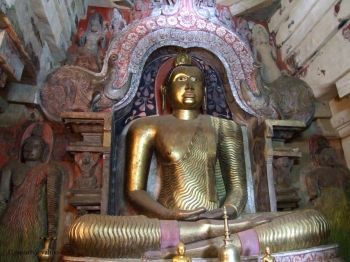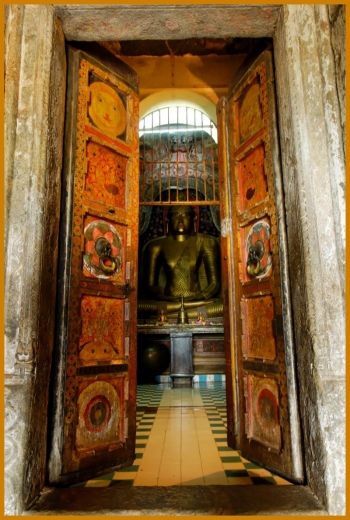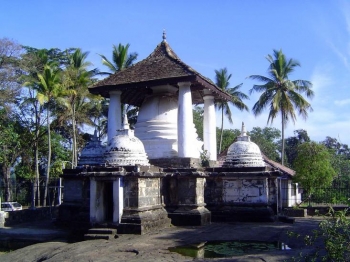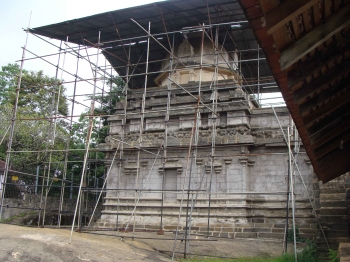Gadaladeniya Sri Saddharmathilaka Temple sits on the apex of a small hill beyond the 65th milepost of the Kandy-Colombo highway, close to Pilimatalawa. It is a prime example of Sri Lankan rock temple architecture of the golden years of the Gampola kingdom (1341–1415). Based on evidence from a rock inscription, the temple is believed to have been erected in 1344 during the reign of King Buvanekabahu IV (1341–51).
The main building of Gadaladeniya Temple is an example of Sri Lankan architecture called “Gedige,” referring to a structure made from a single medium of rough, brittle granite called Kadugannawa neisse. The temple’s main building is presumed to be the largest structure belonging to the Gedige tradition.
Contemporary literature mentions that the temple was conceived by a respected scholarly monk named Venerable Shilawansha Dharmakeerthi (dates unknown), who is said to have traveled to the ancient city of Amaravati, in present-day Maharashtra State, India. Upon his return, Buvanekabahu IV built Gadaladeniya Temple as a dwelling place for the venerated monk. Interestingly, the construction was supervised by Ven. Dharmakeerthi himself, with the assistance of its chief architect, Ganeshvaracharya from South India.
The design of both the inner chamber and the entrance bears an affinity to the architectural style of South Indian temples. Strong, elaborately carved stone pillars support the granite ceiling of the verandah, while the entrance is guarded by stone elephants instead of the usual doratupala or “doorkeeper” statues frequently found in temple architecture prior to the Gampola era. However, the colorful door to the inner chamber has the characteristic features of flowers and bright colors used in Sri Lankan Buddhist architecture. The fusion of Hindu and Buddhist elements in the temple’s design is a clear indication of the Indian cultural influence imbibed by Ven. Dharmakeerthi during his travels.
Another Hindu architectural feature can be found in the placement of the area where devotees worshipped the god Vishnu, also known as Upulvan, who is one of the four gods responsible for safeguarding Buddhism. Its close proximity to the primary entrance to the main hall, where Buddhist practices were performed, is a significant indicator of Hinduism permeating the traditional Buddhist belief system of the Sri Lankan mindset. The giant Buddha statue in the main hall also displays Hindu aspects in the personality of the face. The gaze of the Enlightened One appears rather stern, reflecting the expressions of statues in the Hindu pantheon instead of the usual calm demeanor of Buddha images. These distinctive characteristics of the main building undoubtedly relate to the “Vijayanagar” tradition (sturdy buildings of granite with inner chambers placed inside for worship) of South India.
Outside the main building, the 40-foot-high Vijayothpada stupa is surrounded by four smaller ones. In Buddhist architecture, such elevated structures generally represent the heavenly planes of existence ruled by Shakra, the leader of the gods in Buddhist mythology.
The temple attracts many foreign tourists, local devotees, and other visitors: for example, every year photography students from the University of Peradeniya visit the grounds for a one-day workshop on architectural photography. “This [July] is not the tourist season,” comments Thilakerathna, who grew up in and around the temple. “I’m 52 years old and I have been working in the temple and giving its visitors a small guided tour since I was a kid. There will be many visitors coming here in August with the Kandy street procession season, but the best time to come here is September in time for our own street procession, with elephants parading the streets.”


















